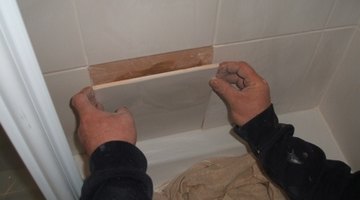How to Remove Tile Adhesive From Plaster
Tile adhesive is always left behind on the wall when a previous tile installation is removed. This is a problem when you want to install new tile or paint the walls. Mastic dries to a hard concrete-like substance that will not just wash off. Mastic can be sanded, but the process takes hours of labor and creates a massive amount of airborne dust that must be contained. Attempting to chisel the mastic off will tear up the walls. The solution is to use a chemical mastic remover. A mastic remover will soften the adhesive so that you can scrape it off the walls without causing damage.

-
Remove all items from the work area. Cover the countertop, floor or bathtub with plastic drop cloths followed by a layer of paper drop cloths. The paper drop cloths will keep the adhesive remover from running off of the plastic drop cloths.
-
Saturate the mastic with adhesive remover and allow it to sit for the manufacturer's recommended amount of time. Times will vary depending on the strength and chemical makeup of the product. Periodically check the wall at 10-minute intervals to make sure that the adhesive remover is not drying. Spray adhesive remover on any dry areas.
-
Scrape the mastic off of the wall with a metal scraper. Plastic scrapers may dissolve with the use of some adhesive removers. Place the scraped mastic into a cardboard box. Repeat step 2 if the first application of adhesive remover does not clean off all of the mastic.
-
Fill a bucket with warm, soapy water and wash the adhesive and mastic residue from the walls. Rinse with clean, warm water.
Resources
Tips
- Carefully read the label of all mastic solvents. Not all solvents are designed to be used on walls.
Warnings
- Follow all safety precautions. Some adhesive removers require that you wear a respirator.
Writer Bio
Based in Oklahoma City, Debbie Tolle has been working in the home-improvement industry since 2001 and writing since 1998. Tolle holds a Master of Science in psychology from Eastern Illinois University and is also a Cisco-certified network associate (CCNA) and a Microsoft-certified systems engineer (MCSE).
Photo Credits
- Tiler replacing wall tile in shower cubicle image by Bryan Clark from Fotolia.com
More Articles



